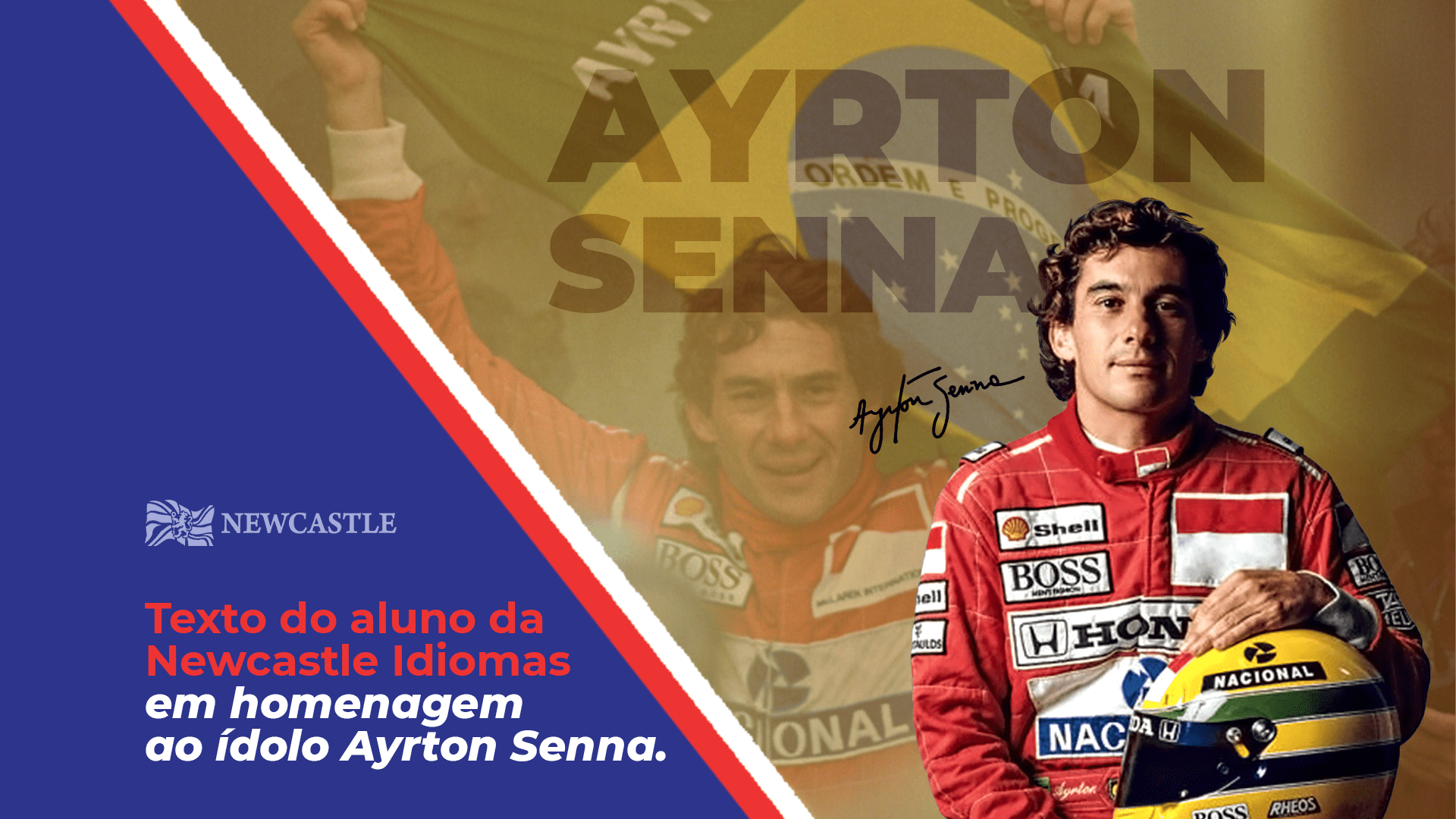Hello, everybody!
I hope you are doing fine.
Como forma de reconhecimento à dedicação e ao comprometimento com os estudos, parabenizamos o aluno da unidade Newcastle de Sorocaba, Eduardo Porto Ferreira, aluno do Interaction (nível intermediário), pela criação do texto/redação em tributo ao piloto de Fórmula 1 Ayrton Senna, o maior ídolo brasileiro do automobilismo.
A Newcastle Idiomas e todo o setor pedagógico reconhece esforço e dedicação de cada um de nossos alunos.

O texto na íntegra você acompanha abaixo. Boa leitura!
THE HISTORY OF A LEGEND
THE FASTEST FORMULA ONE DRIVER OF ALL TIME
AYRTON SENNA DA SILVA OR AYRTON SENNA OF BRAZIL
Holding 41 victories, 3 Driver’s World Championships, and 65 poles Ayrton Senna is considered, by many people, the best Formula One driver of all time. Even not having the best numbers in history, there is no doubt Senna is a legend of the sport.
THE BEGINNING
Ayrton Senna debuted on Formula One on March 25th, 1984, at Brazil’s GP, held in Jacarepaguá Circuit in Rio de Janeiro. Unfortunately, he did not complete the race, due to problems with his toleman’s engine. But it didn’t take long for him to glow, right on his second race, he scored his first point on Formula One, in Kyalami, South Africa’s GP.
Despite his inexperience, his best race on this season was in Monaco’s GP, where – under heavy rain – he has gotten a stunning second place. He was approaching Alain Prost, overtaking was just a matter of time, but suddenly, they have decided to interrupt the race, because the rain had turned into a storm.
After starting in 13th place and finishing in the 2nd, all the Formula One’s teams have turned their eyes to Senna. In that same season, he got two more podiums (British’s GP, in Brands Hatch and Portugal’s GP, in Estoril). And just like that, he ended the season in the 9th position at the Driver’s World Championship.
1985
In the 1985 season, Ayrton Senna was transferred to Lotus, where he got his first victory, under heavy rain (again!). It was a marvelous weekend for him in Portugal’s GP, in Estoril. That was a remarkable season, in which he won Belgium’s GP, in Spa-Francorchamps – again under the rain. Although he had ended up in the 4th position, he was considered to be the best driver of the whole season, letting it be understood that he was one of the best drivers in adverse conditions. He finished the season on six podiums (twice the winner, twice second place, and twice third place), adding up 38 points.
1986
The 1986 season began well for Senna, who was still partnered with Lotus and got second place in Brazil’s GP – which was won by Nelson Piquet, from Williams. The second race of the season, held in Jerez de la Frontera (Spain’s GP), brought Ayrton Senna’s first victory. The Brazilian beat Williams’ driver, Nigel Mansell, in a thrilling race in which Senna ended only 0,014 seconds ahead of Mansell – one of the shortest time differences in the history of Formula One.
Knowing he did not have the best car – Williams’ and Mc’Laren’s were better than Lotus – Senna adopted the strategy of not going to the pits to swap his tires. This smart yet risky strategy led him to be the championship’s lead, even if not for so long. However, Ayrton Senna became an idol to Brazilian fans, after his second victory in Detroit, USA.
The 86’s season ended with his 55 points – earned in six podiums, two victories, and eight pole positions.
THE CONSOLIDATION OF A LEGEND
1987
The season of 1987 came along with a lot of hope and expectations. Lotus was now sponsored by Camel and partnered with Honda, for the manufacture of the teams’ engines, after Renault has left the sport as an engine supplier. Following a weak start in the season, Senna won two GPs in a row, Monaco’s GP (his first victory of six in that circuit), and USA’s GP (in Detroit). Again, he led the championship, however, Williams still had the best car on the grid.
Senna lost the title battle in Mexico’s GP, after a clutch failure. But after one of Williams’ racers, Nigel Mansell, has had an accident during practice that left him a huge back injury, Senna had a chance to take second place in the world championship. However, he would still have to end the two remaining races (Japan and Australia) on the podium to achieve second place, and so he did it. All was great until FIA found an irregularity on the Lotus breaks (at the Australian GP), and by regulation, he was declassified.
Just like this, the Brazilian idol ended up in third place at the Drivers’ World Championship. Right behind Brazilian’s world champion, Nelson Piquet, and the British, Mansell. He scored 57 points, one pole, and eight podiums (two victories, four second places, and two third places).
Right after that season ended, Senna was hired by McLaren, and his career took off.
1988
In McLaren, along with Alain Prost, Ayrton Senna has won his first Drivers’ World Championship. McLaren won fifteen of the sixteen races of the season, in which Senna won eight of them, and Prost won seven. It was a remarkable season for McLaren.
One of the main moments of the season was in Monaco, where Senna got the pole for the race. According to Ayrton Senna himself, he was driving in another dimension, somehow, he has not had the consciousness of what was happening, and he managed to complete a lap 1,4 seconds faster than Prost, the second place. The Brazilian was leading the race, he was ahead of his teammate by almost a minute, when, at the entrance of the tunnel, Senna hit the guard rail and lost that race, which was won by Alain Prost.
Ayrton Senna won the championship in Japan’s GP in an exciting race. Senna got the pole, but, in the beginning, the car shut off and he managed to start it again, but it took him to swap from first to 17th place. So, you might be thinking, he must have lost, right?
No! Already on the first lap, he overtook eight opponents and on lap 28 he passed Prost, ending the race thirteen seconds ahead of him. It was another fantastic race of Senna, the one that earned him the title of the season. Beyond the eight memorable victories, our Brazilian also got 3 podiums, all of them at second place.
THE RIVALRY GOLDEN DAYS
1989
In the season of 1989, the rivalry of Senna and Prost became even tenser. In San Marino’s GP, Senna made a deal with Prost to try to prevent an accident like the one that happened in the Brazilian GP one month before.
In that race, Senna got the pole, but on the first lap, he got involved in an accident with Gerhard Berger and Ricardo Patrese, which led him to leave.
So, the deal with Prost was: they would not attack each other on the first corner after the start. Prost agreed on it, and with no surprises, Senna and Prost started the GP in the first row.
Despite the great start of our Brazilian, and the fact that he was maintaining the first position, the race had to be interrupted, due to a huge accident with Gerhard Berger at the Tamburello, which set his car on fire. Fortunately, Berger managed to escape unscathed, therefore, after the red flag, the race restarted. That was when Prost pulled better than Senna and took the lead, but that didn’t last long. Ayrton Senna, in that very same lap, overtook the French’s position on the Tosa corner. The agreement had been broken and the war was declared. This “war” is, until today, considered to be the biggest and most fierce rivalry in the history of Formula One.
Prost was angry and felt betrayed by Senna – this was about to change not only the Formula One history, but also McLaren’s. Senna defended himself by saying that the agreement would only be valid for the actual start, and not the restart. However, Prost was not convinced. The French driver was more consistent along the season and in its penultimate race, decided in Japan, he had the chance to get the world championship. On the other hand, Senna had the chance to postpone the decision to Australia if he won the race.
Again, for Brazil’s pride, Senna got the pole with sovereignty, being 1,730 seconds faster than Prost. Yet, he did not start well, and Prost jumped to the first place. Still, Senna was chasing fiercely, pretty close to Prost, who was not willing to let him pass, nevertheless, on the 47th lap, Senna tried to surpass the French – on the last chicane – who reacted by blocking the door and hitting Senna. After the accident, Prost had to abandon the race. Senna, on the other hand, was willing to get back there, even considering how damaged his car was, so he crossed the chicane and managed to turn his car back on. He got back on the lane and had a breakdown in his car, so he went to the pits to fix most everything. Still, he was able to get back there in second, and not long after getting back, he surpassed Alessandro Navini (Benneton) and conquered the first place, postponing the decision to the final race. секс бесплатно
However, before the last race of the season, the compatriot of Prost and FIA’s president, Jean-Marie Balestre, decided to disqualify Senna from Japan’s race, claiming Senna passed through a prohibited area after the collision with Prost, and just like that, Prost was the champion of the world in 1989. Some years later, Balestre admitted, “I’ve done this to benefit Prost”. Senna was so furious; he almost did not participate in next year’s season. Yet, the Brazilian ended the 89’s season getting 7 podiums (six victories and one second place).
1990
In the season of 1990, Alain Prost no longer wanted to be part of McLaren’s team, so he moved to Ferrari, where we led a project meant to put Scuderia on the top again, once the Tifosis hadn’t won a championship since 1979. Gerhard Berger replaced Prost and – once more – it was Ayrton Senna and Alain Prost fighting for the title, in a battle to be decided – again! – in Japan. However, the drivers have swapped their roles, because this time it was Prost who had to win the race to postpone the decision to the final race, in Australia. Before the race started, Senna had declared “I won’t let Prost surpass me on the first corner”. Even getting the pole, the race didn’t start very well for our Brazilian, and Prost jumped to the first place, but right in the first corner Senna, purposely threw the car on Prost’s at 270km/h, pulling both drivers out of the lane. Once both left the race, Senna got his second World Drivers’ Championship. In this season, Senna added up eleven podiums (6 wins, 2 second places, and 3 third places), earning 78 points.
1991
In 1991, Senna had a taboo to break, he had never won the Brazilian GP. After his victory in the first race in the USA, the next Formula One race was held in Interlagos, the Brazilian race track that Senna himself helped to design. The qualifying race was balanced, but Senna still got the pole (the 54th of his career) and was holding the first position. Nigel Mansell (Williams) overtook his teammate Ricardo Patrese, becoming the second place, and along with Senna, they dictated the pale of the race.
As soon as they left the pit stops, Senna continued leading the race, while Mansell lost some of his advantage, and on the 61st lap, he spun out of the race. Now Senna was ahead of Ricardo Patrese (the second place) by 40 seconds, the race seemed to be won until Senna had a major issue with his gearbox, the fourth gear was not working, and with only five laps remaining, the third and fifth gear also broke, and he had to finish it using only the sixth gear, what made his great advantage turndown to only three seconds on the final lap. After some massive struggle, Senna finally won the Brazilian GP, but his aching was so agonizing he had to be lifted out of the car and driven to the podium in the medical car. This was one of the most iconic races of Senna’s and Formula One’s history.
Once again, after 14 races, Senna conquered the World Championship in Japan’s GP, beating Nigel Mansell. Of all the 16 races, Senna got up on that podium twelve times (7 victories, 3 second places, and 2 third places), ending the championship with 98 points.
1992
The season of 1992 was dominated by Williams, so Nigel Mansell easily won the Drivers’ World Championship, when there were still five races remaining in the season. McLaren, though, was not organized at all. Yet, Senna managed to win three races. One of them was iconic, Monaco’s GP, Senna did not get the pole, it was Mansell’s, he had done a stunning lap and conquered it 1.1 seconds faster than Senna, who got the 3rd position, losing for Patrese as well.
At the beginning of the race, Senna jumped to 2nd, overtaking Patrese’s position on the first corner (Sainte Devote). Then, Senna saved his tires to not have to stop at the pits. However, there has been adversity when Michele Alboreto spun on Mirabeau’s turn, and Senna wasted time. For everyone, it seemed like Mansell was going to win, but here is the plot twist: his tire nut came off and he had to go to the pits slowly and unexpectedly. Senna then took the lead, but Mansell – now with fresh tires – was putting a lot of pressure on our Brazilian. Senna handled it well, and by an extremely short time difference, he won another epic race.
His second victory that year was held at Hungaroring, in Hungary’s GP. Still, one of the most memorable moments of the season happened in Belgium’s GP. In the qualifying race, when the French racer, Erick Comas, suffered a huge accident on Blanchimont corner, Senna just parked his car in the middle of the track to turn off Eric’s car engine, to avoid a fire, saving the French’s life. Senna got 4th place in the world championship that year, adding up 7 podiums (three wins, one second place, and three third places) and 50 points.
1992 was also the year that Senna did some tests on Formula Indy, on Penske’s team, along with Emerson Fittipaldi, who was an official driver of the team. Despite his inexperience on the modality, he was faster than Fittipaldi, which almost made him leave Formula One.
1993
In 1993, Senna tried to sign a contract with Williams, but his great rival Alain Prost did it first and one of his clauses was not having Senna as a teammate, once he was determined to win the world championship. Therefore, Senna signed a contract per race with McLaren, until, after some races, he decided to sign with them for the rest of the year.
After a special victory in Brazil’s GP, the Formula One arrived at Dogninton Park, for the European GP, to which Senna qualified in fourth, behind Michael Schumacher (3rd Benetton), Damon Hill (2nd Williams), and Alain Prost (1st Williams).
Williams’ team was so strong that, on that weekend, the only chance for Senna to win the race would be in adverse conditions. Somehow, luck smiled at Senna that Sunday as the rain showed up, and he gifted us with a historical lap. At the beginning of the race, Senna fell to 5th, but not for long, because right on the first lap he has surpassed all of them, one by one, getting first place in a stunning lap, known as “the best lap of Formula One’s history”. During the race, the weather was unstable and unpredictable, and even with (or due to) the wetness of the track, he was the fastest man on the circuit, which helped him, once he has only pitted four times, while Prost pitted seven times, and wasted the second place to his teammate Damon Hill. Ayrton Senna won the race being 1m23s199 in front of Hill, and a whole lap ahead of Prost. Another Brazilian show.
In that same year, Senna became “the king of Monaco”, winning their GP for the sixth time, a record held until today. Throughout the championship, Senna won two more races. Prost won his fourth world championship, while Senna got second place, getting up on 7 podiums (five wins and two second places), earning 73 points. Right after his remarkable accomplishment, Prost decided to retire from Formula One, therefore, Senna could finally sign with Williams for the season of 1994.
DEATH AND LEGACY
1994
In 1994, in an attempt to make Formula One more balanced, FIA decided to ban some electronics assistances. Those changes, along with its development, made the car faster, yet trickier, and all the drivers complained about the danger. Williams had powerful engines, which – without the assistances – made the car unstable.
The first race of the season happened in Brazil, in which Senna got the pole, but lost the position to Michael Schumacher, while on the pits. Trying to reach the German, Senna spun out of the race. Then, the competition went to Japan for the Pacific GP, where once again, Senna got the pole. However, right on the first corner, Senna was hit by Mika Häkkinen and Nicola Larini and had to get out of the race.
On April 29th, 1994, the most tragic weekend of Formula One had begun. Without any points, Senna arrived at the Enzo e Dino Ferrari circuit, in Imola, Italy, ready to conquer his first victory. Things started to get out of control when on Friday, Rubens Barrichello almost died in a huge accident on the Variante Basa corner, which left all the drivers worried about the safety of Formula One. The next day, in the qualifying race, there was another horrible crash, on Villeneuve corner, that ended up in Rolland Ratzenberger’s death. The Austrian lost control and hit the wall at 314km/h, dying almost instantly. FIA, as demands the rules, should have canceled the GP weekend, but they haven’t, because FIA omitted the facts, claiming Ratzenberger hadn’t died in the circuit.
Thus, the race started with Senna in the pole position. He started well and was opening up an advantage over Schumacher when on the 7th lap, bypassing the Tamburello corner, the steering bar of his Williams broke, and struggling to break the car, Ayrton Senna hit the wall at 233km/h.
After a slight movement of his head, everyone thought he was still alive, but in fact, the movement was a reflection of severe brain damage, caused as a piece of the car’s suspension jutted out like a spear and pierced his head, resulting in his brain death on the track. Unfortunately, FIA omitted the facts once again, and the race continued, having Michael Schumacher as a winner.
At 1:40 pm (Brasilia time), Roberto Cabrini, on Globo live television, announced the death of Ayrton Senna, leaving the Brazilian people desolated.
Ayrton Senna was one of the most important figures of Formula One and Brazil. His performances, on track, as well as out of them, enchanted the whole world and turned him into a legend and a hero. Because his heroic races brought happiness and proudness to the Brazilian people and his death devastated the world. His life story – until this day – inspires a lot of people. He gave us an example with his dedication and hard work on how to achieve everything you dream of. His races, his legacy, and his name will always be remembered. All respect for Ayrton Senna.
TRIBUTE FOR AYRTON SENNA DA SILVA
OR AYRTON SENNA DO BRASIL
Espero que tenham gostado do texto do Eduardo e tenham aproveitado para praticar a habilidade de leitura em inglês.
Fique agora com 10 momentos de Ayrton Senna na Fórmula 1.
Clique aqui para acessar o canal Oficial da Formula 1 no Youtube.
Ah, e antes de ir embora, não deixe de conferir o nosso último post clicando no link abaixo:
Pull vs Push: Não confunda mais!
That’s it for today.
See ya!
Se você está procurando uma escola de idiomas, com um ótimo custo beneficio e uma metodologia que permite que você estude inglês todos os dias.
A Newcastle é a escolha certa para você!








